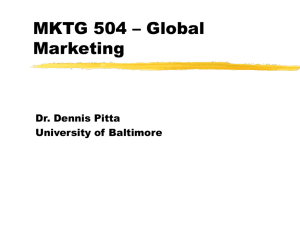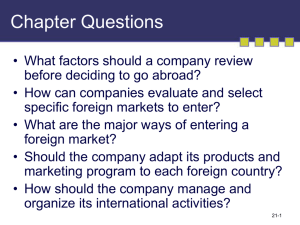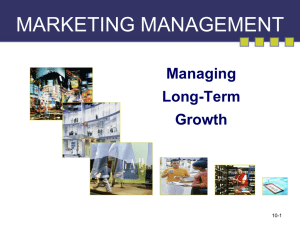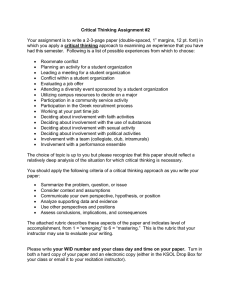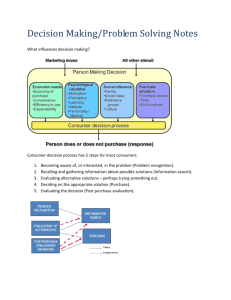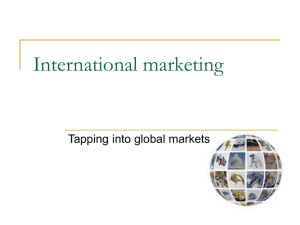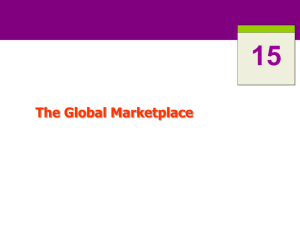KotlerMM_ch21 - UMM Directory
advertisement
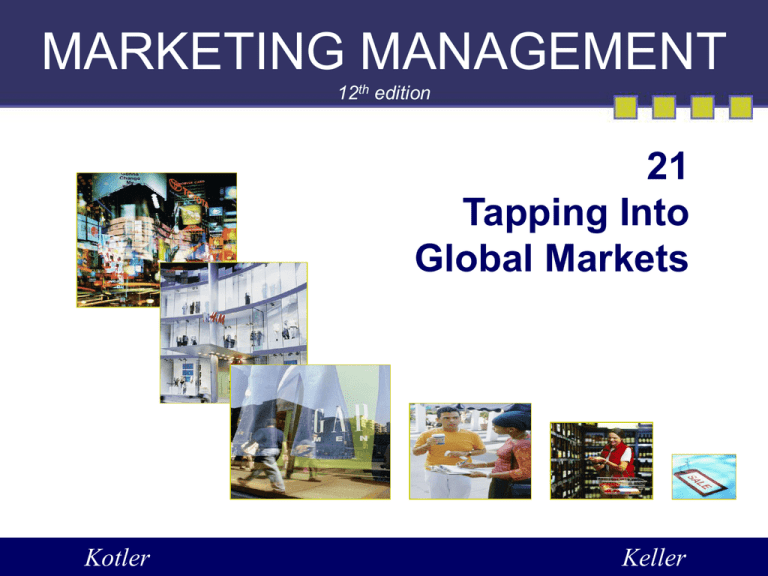
MARKETING MANAGEMENT 12th edition 21 Tapping Into Global Markets Kotler Keller Chapter Questions • What factors should a company review before deciding to go abroad? • How can companies evaluate and select specific foreign markets to enter? • What are the major ways of entering a foreign market? • To what extent must the company adapt its products and marketing program to each foreign country? • How should the company manage and organize its international activities? 21-2 Red Bull Markets Globally 21-3 Global Firm A firm that operates in more than one country and captures R&D, production, logistical, marketing, and financial advantages in its costs and reputation that are not available to purely domestic competitors. 21-4 Major Decisions in International Marketing Deciding whether to go Deciding which markets to enter Deciding how to enter Deciding on the marketing program Deciding on the marketing organization 21-5 Four Stages of Internationalization No regular export activities Export via independent agents Establish sales subsidiaries Establish production facilities abroad 21-6 Nescafe Markets in Russia 21-7 Regional Free Trade Zones • • • • European Union NAFTA MERCOSUL APEC 21-8 Figure 21.2 Five Modes of Entry into Foreign Markets Indirect exporting Direct exporting Licensing Joint ventures Direct investment Commitment, Risk, Control, Profit Potential 21-9 Direct Exporting Methods • • • • Domestic-based export department Overseas sales branch or subsidiary Traveling export sales representatives Foreign-based distributors or agents 21-10 McDonald’s Franchises Are Sold Worldwide 21-11 Table 21.1 Global Marketing Advantages • Economies of scale • Lower marketing costs • Power and scope • Consistency in brand image • Ability to leverage • Uniformity of marketing practices Disadvantages • Differences in consumer needs, wants, usage patterns • Differences in consumer response to marketing mix • Differences in brand development process • Differences in environment 21-12 Cultural Dimensions Individualism vs. Collectivism High vs. Low Power Distance Masculine vs. Feminine Weak vs. Strong Uncertainty Avoidance 21-13 Figure 21.3 International Product and Communication Strategies 21-14 Communications • Communications adaptation • Dual adaptation 21-15 Price Choices • Set a uniform price everywhere • Set a market-based price in each country • Set a cost-based price in each country 21-16 Figure 21.4 Whole-Channel Concept for International Marketing Seller International headquarters Channels between nations Channels within nations Final buyers 21-17 Country of Origin Effects 21-18 EU’s PDO and PGI Listings 21-19 Global Organization Strategies World as Single Market Multinational “Glocal” 21-20 Marketing Debate Is the world coming closer together? Take a position: 1. People are becoming more and more similar. 2. The differences between people of different cultures far outweigh their similarities. 21-21 Marketing Discussion Think of some of your favorite brands. Do you know where they come from? Where and how they are made or provided? Do you think it would affect your perceptions of quality or satisfaction? 21-22

